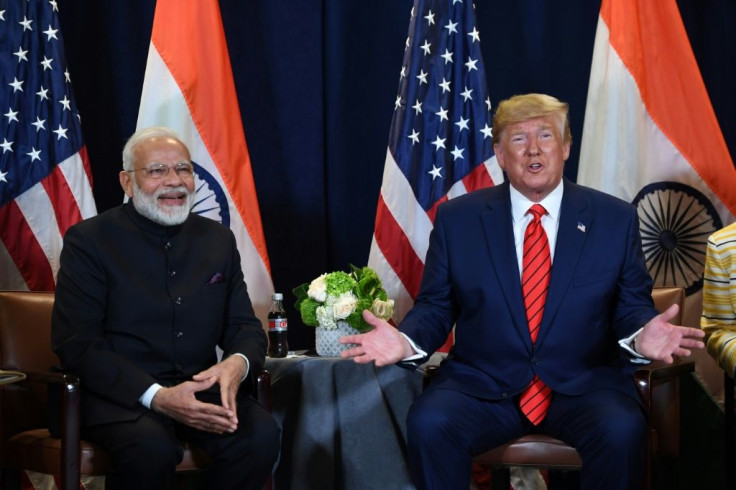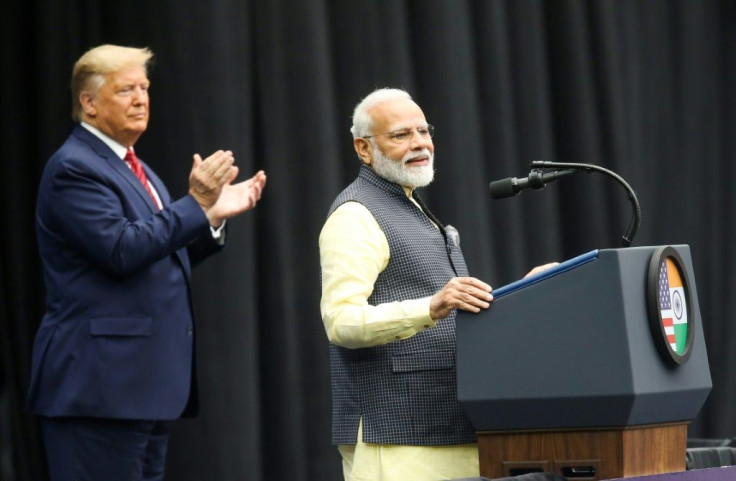Trump India Visit: President Says 'Big Trade Deal' Will Be Signed Only Later

KEY POINTS
- President Trump hints at a "large" trade deal with India in future
- Dropping India from the GSP list has affected ties between Washington and New Delhi
- Trump may be unhappy that India bought the Russian S-400 air defense system
After President Donald Trump expressed doubt about signing a major trade deal with India during his Feb. 24-25 week’s visit to the country, expectation of anything substantive coming out of it have reduced. It is more about the optics than anything else now.
Trump's words that “I happen to like Prime Minister (Narendra) Modi a lot” have added spice to Indian media coverage. The President’s is scheduled to jointly address a meeting with Prime Minister Modi at a 100,000-capacity cricket stadium in the latter’s home state of Gujarat. The reception, which New Delhi has named 'Namaste Trump,' or welcome Trump, is expected to be a replication of the hugely successful 'Howdy, Modi' event in Houston that the two leaders attended in September last year.
The Economic Times reported that one of the main hurdles on the way to a trade deal was India's insistence on mandatory certification of U.S. dairy products that the source animal was not raised on feed made of bovine extracts. The issue is important for India because of its religious overtone -- the cow is revered in large parts of the country. The European Union, Australia and New Zealand provide this certification currently, the report said.
'Very big deal' in future?
“We can have a trade deal with India. But I'm really saving the big deal for later,” Trump said. "We’re doing a very big trade deal with India. We'll have it. I don't know if it’ll be done before the election, but we'll have a very big deal with India.”

U.S. Trade Representative Robert Lighthizer, the point-person for trade talks with India, is not accompanying Trump, as some Indian media reports had speculate initially. n 2018-19, India’s exports to the U.S. stood at $52.4 billion, while imports were at $35.5 billion.
Washington’s dissatisfaction with some of New Delhi’s policies were evident when Trump said: “We’re not treated very well by India.” But the President said he was excited about the visit. “He (Prime Minister Modi) told me we’ll have seven million people between the airport and the event. And the stadium, I understand, is sort of semi under construction, but it's going to be the largest stadium in the world. So it's going to be very exciting ... I hope you all enjoy it.”
Setback in ties
U.S.-India ties suffered a setback in June last year when President Trump removed India from the Generalized System of Preferences, or GSP. A GSP listing allows tariff-free access to the U.S. market for some products from designated developing countries. He raised tariffs on 14% of imports from India, according to an article in the US-India Strategic and Partnership Forum, or USISPF.
India had been one of the largest beneficiaries of the GSP with the export of goods worth nearly $6.3 billion to the U.S. under the GSP, which was around 12.1% of India’s total export to the U.S. in 2018, Piyush Goyal, India’s trade minister told Indian Parliament in December last year. (India’s financial year runs from April to March.) This meant Indian businesses benefited to the tune of $240 million. Exports worth about $5.7 billion got GSP benefits in 2017.
The decision to remove India from the GSP was the culmination of a review process that began in April, 2018, that looked at the objections raised by the U.S. dairy and medical devices industries, according to a report in the Economic Times. “During the process of GSP review, USTR added various demands including greater market access for a number of its products and used the non-reciprocal GSP benefit as a lever to extract further concessions from India,” Goyal said.

The USISPF reported that the cumulative bilateral trade growth between the two countries for 2019 in the third-quarter slid to 4.5%, from 8.4% in the first two quarters, according to a report on Indian TV channel News 18. The report cites reasons like the unexpected slowdown in India’s growth, the impact of the U.S.-China trade war, withdrawal of GSP status for India and retaliatory tariffs on specific U.S. goods from Indian for the decline.
Although the United States and India have a strong strategic bond, mainly to counter the rise of China in the region, New Delhi's recent $5.4 billion deal to buy the Russian S400 air defense system did not go down well with Washington. India’s continued refusal to rule out the use of 5G technology from Chinese giant Huawei despite a U.S. advice may have also put off the Trump administration.
© Copyright IBTimes 2024. All rights reserved.




















